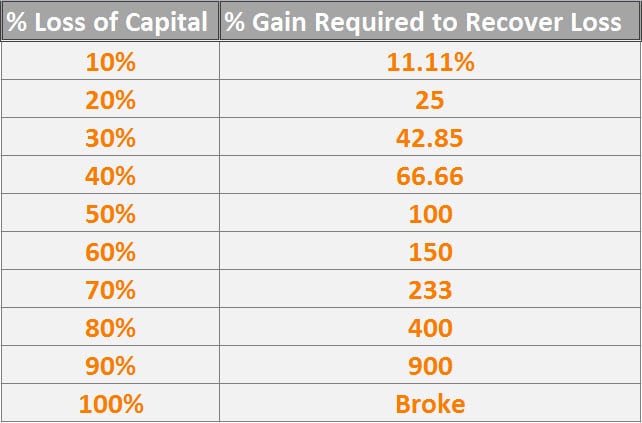Working out how to set up your risk management plan is quite a big question. In fact, there are a hell of a lot of things to think about and different aspects to implement. Due to that fact it will be impossible for us to tell you about all of them, as some are individual to each trader. We can, however, go over some of the different things to think about when it comes to your risk management plan. It is up to you how much you do, but remember, one of the keys to being a successful trader is that you have a proper risk management plan in place, to protect your trades, your accounts, and your overall capital. So let’s take a look at some of the things that we should be thinking about when we are setting up our risk management plans.
The first thing that you are going to need to do is simply gain an understanding of what trading is and how it works. There is no bigger risk than to try a trade without actually understanding how it works. So while this won’t exactly go into your risk management plan, you can’t really start to create your plan without actually understanding what it is that you are creating. Trading and forex is a never-ending learning hobby, you will be constantly learning and will never know everything, this also means that you will be constantly learning new ways to reduce risks, so be sure that you are aware of this and always willing to learn more about forex and trading.
You then need to understand how leverage works, it can be a gift but also a curse. Leverage basically allows you to trade with more capital than you have in the account, sounds fantastic, but with this increased trading power also comes increased risks. With leverage of 100:1, you can use a $1,000 account to trade the equivalent of $100,000. This enables you to increase the trade sizes that you can put on, increasing your profit potential, but these larger trade sizes also mean that you have the potential to lose far more with each trade. Ensure that you know the risk of the leverage that you are using, do not go too high, as this can cause issues depending on your strategy, we would suggest not going over 500:1 for any strategy.

You then need to get your trading plan sorted, you need to decide on a strategy that you wish to use, there are hundreds of them out there, try and find one that suits you, something that goes along with your personality. If you hate waiting then go for a shorter time frame strategy like scalping, if you do not have much time to sit at the computer then go for a longer-term one like position or swing trading. This trading plan should also act as a sort of decision-making tool for you when you wish to place a trade. To set out some rules that you need to follow, they will help you work out the right entry and exit price for you to place your trades with. When you do this, you should also keep your trading journal to detail the trades that you make to ensure that they are all in line with your strategy.
You can also set a risk to reward ratio, this is basically detailing how much you are going to risk in order to make a certain amount of money. Many people go for at least 1:3, this means that for every $1 that you risk you will want to try and make $3. For a $100 trade would potentially lose $100 but will have a potential profit of $300. This sort of strategy will mean that you can be wrong more times than right and still be in profit. It is important to set this out correctly as it can make it far easier to work out where to place stop loss and take profit levels.
We briefly mentioned them but you need to learn to use a stop loss and take profits with every single trade that you take. If you place a trade without a stop loss then you are potentially risking the entire account balance on a single trade with a risk to reward ratio of infinite losses. These are paramount to protecting your account from trades gone bad, we don’t need to explain the importance, but any sort of successful trader will be using stop losses.
Learn to control your emotions, something that you have probably heard before, but it is important when it comes to being consistent and minimising losses. Emotions such as greed and overconfidence can really hurt your trading efforts, causing you to place trades that you probably shouldn’t or placing trades that are larger than your account or risk management can take. Try to avoid using these emotions to trade with, if you feel them coming on then work out some coping mechanisms, even if that is as simple as simply walking off and going outside for a bit. If you are feeling emotional or have clouded vision, then try to avoid trading at those times.

Keep an eye out for the news, the news can cause huge movements and spikes in the market, so knowing what news events are coming up and how they may affect the markets can give you an advantage and the opportunity to get out of the markets before they happen. It is always advised that you do not trade during news events or disasters, so knowing when they are coming up (news events that are) will give you the opportunity to get out before they cause the markets to move. It is impossible to see them all coming but knowing some of them will at least be helpful.
You should also get to know the limits of your account, if you have a balance of $1,000 you will have very different limits to someone with an account of $10,000. There will be different possibilities when it comes to trade sizes and the risk management that you can do, as well as different profit potentials. This isn’t a large point, but just be aware of your limits so you do not over-trade on your account.
The final thing that you should be doing is using a demo account, every change that you make to your strategy or your plans you should demo the changes first, this ensures that you are not risking your own money on an untested change. Try the change for a period of time before you do anything else on a live account. Demo demo demo, that is the moral of the story and if you don’t there is a very good chance that your account will eventually blow.
So those are some of the things that you can do and that you should be thinking about when it comes to creating your risk management plan and policy, there are of course other things to think about, but doing at least these things will give you a good starting point for it.

